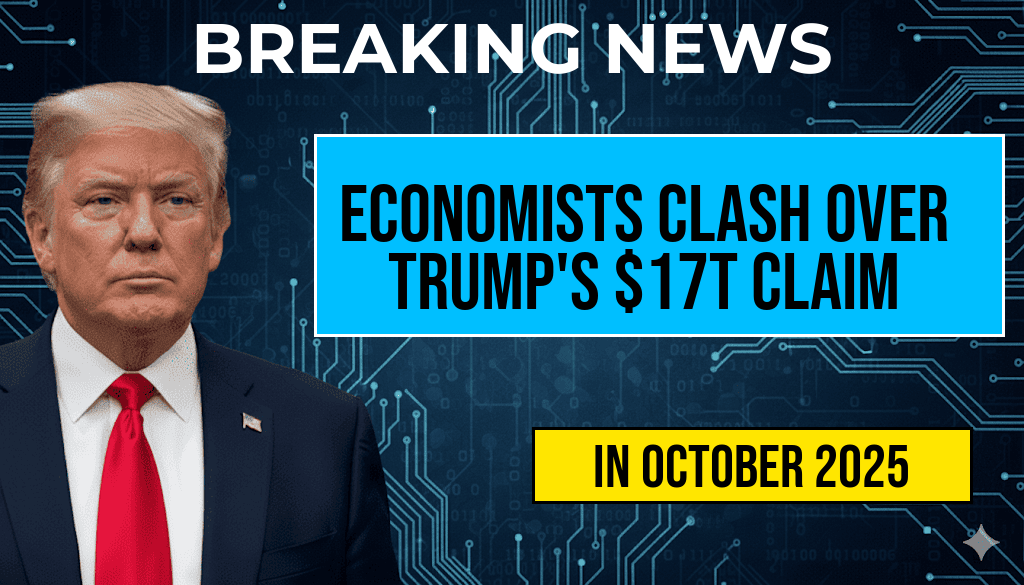Amid mounting economic debates, former President Donald Trump has made bold claims about the scale of his global investment influence, asserting that his financial activities encompass a staggering $17 trillion. These remarks have ignited fierce disagreements among economists, who question the feasibility and accuracy of such figures, and whether they reflect actual investments or are hyperbolic estimates. While Trump’s supporters hail his supposed economic prowess, critics argue that these numbers lack transparency and are inflated for political or rhetorical effect. As the debate unfolds, financial analysts and policymakers are scrutinizing the origins of these claims, examining the implications for international markets, and evaluating what they reveal about the broader narrative of American economic power in a shifting global landscape.
Dissecting the $17 Trillion Figure
The Origin of the Claim
Trump first introduced the “$17 trillion” figure during a rally speech, suggesting that his personal global investments and influence surpass the gross domestic product (GDP) of many nations combined. In interviews and social media posts, he emphasized that his business empire, which spans real estate, licensing, and international ventures, encompasses assets and investments across multiple continents. However, experts note that the figure appears to combine various estimates, including private investments, market influence, and indirect economic contributions, rather than clear-cut asset valuations.
Economic Realities and Measurement Challenges
Measuring total investment influence at this scale presents inherent difficulties. Unlike national GDP, which is based on measurable production, the “$17 trillion” figure aggregates diverse components such as:
- Direct foreign investments
- Business holdings
- Influence over international markets
- Real estate holdings
- Licensing and branding deals
Estimating the combined worth of these elements involves significant assumptions, often relying on speculative or incomplete data, which raises questions about the figure’s precision.
Economists’ Perspectives and Criticisms
Questioning the Validity of the Number
Leading economists caution against taking such figures at face value. Dr. Lisa Chen, a professor of international economics at Harvard University, states, “While Trump’s business interests are extensive, conflating investment influence with a cumulative dollar amount is misleading. There’s a difference between owning assets and exerting economic influence, which is far harder to quantify.”
Inflation of Influence or Genuine Power?
Some analysts argue that Trump’s claims reflect an attempt to project dominance in global markets, akin to a form of economic soft power. However, others emphasize that actual investment figures are more modest than suggested, and that claims of $17 trillion may be an exaggerated narrative designed for political advantage.
Impact on Markets and International Relations
Despite skepticism, the claims have stirred discussions among investors and policymakers about the size and scope of American economic influence. The potential implications for international trade relations, foreign investment climates, and diplomatic negotiations are topics of active debate. Some see the figure as a reflection of the importance of private enterprise in shaping U.S. global stature, while others warn it risks misleading stakeholders about the true scale of influence.
The Broader Context of Global Investment
U.S. and Global Investment Trends
The United States remains a dominant player in global investments, with direct foreign investments totaling approximately $4.5 trillion in recent years, according to the U.S. Bureau of Economic Analysis. The broader influence of American corporations and entrepreneurs extends beyond direct investments, impacting international markets through trade, technology, and cultural exports.
Comparative Analysis with Other Economies
| Country | Foreign Investment (USD Trillions) |
|---|---|
| United States | $4.5 |
| China | $2.2 |
| European Union | $3.1 |
| Japan | $1.8 |
While the aggregated figures for individual countries are substantial, they pale in comparison to the claimed $17 trillion influence attributed to Trump, highlighting the challenge of translating broad economic contributions into concrete investment numbers.
Public and Political Reactions
Supporters’ Perspective
Trump’s allies emphasize that his claims underscore the strength of his business dealings and the global reach of his brand. They argue that such influence is vital for advancing American interests abroad and fostering economic growth domestically.
Critics’ Counterarguments
Opponents dismiss the $17 trillion figure as hyperbole, warning that it blurs the line between genuine economic influence and inflated rhetoric. They caution that overestimating the scale of influence could mislead investors and policymakers about the actual state of U.S. economic power.
Looking Ahead
The debate over Trump’s bold assertions encapsulates broader questions about the measurement of economic influence in a globalized world. As the discourse continues, analysts stress the importance of transparency and precise data in understanding the true scope of any individual’s or nation’s economic footprint. For now, the $17 trillion figure remains a provocative talking point—one that underscores the challenges of quantifying influence in a complex, interconnected economy.
Frequently Asked Questions
What are the main claims made by President Trump regarding global investments?
President Trump has claimed that his administration has significantly increased global investments and has bolstered the U.S. economy by attracting trillions of dollars in foreign capital.
Why do economists disagree with Trump’s investment claims?
Many economists argue that Trump’s claims are exaggerated or misleading, citing data that show inconsistent or insufficient evidence to support the assertion of a $17 trillion boost in global investments.
What is the significance of the $17 trillion figure mentioned in the article?
The $17 trillion figure represents the claimed increase in global investments attributed to Trump’s policies, which has become a focal point of debate among economists and policymakers.
How do different economists view the impact of Trump’s policies on the global economy?
Some economists believe that Trump’s policies have positively influenced investment flows and economic growth, while others argue that the evidence does not support such claims and that the impact may be overstated.
What are the potential implications of these conflicting views for investors and policymakers?
The disagreement among economists could influence investment decisions and policy formulation, highlighting the importance of critically evaluating claims about global economic growth and investment trends.

Leave a Reply